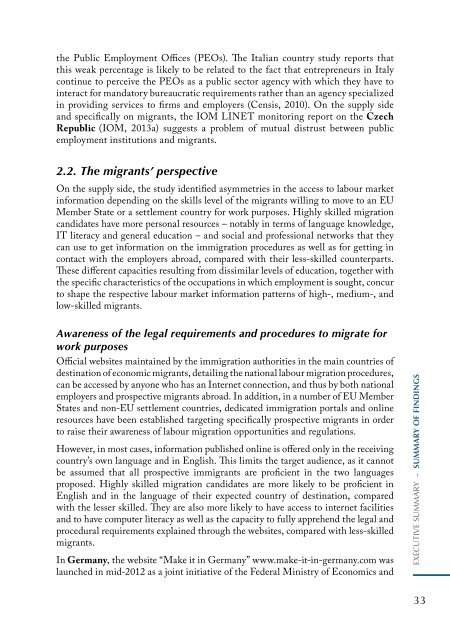International Organization for Migration (IOM)
International Organization for Migration (IOM)
International Organization for Migration (IOM)
You also want an ePaper? Increase the reach of your titles
YUMPU automatically turns print PDFs into web optimized ePapers that Google loves.
the Public Employment Offices (PEOs). The Italian country study reports that<br />
this weak percentage is likely to be related to the fact that entrepreneurs in Italy<br />
continue to perceive the PEOs as a public sector agency with which they have to<br />
interact <strong>for</strong> mandatory bureaucratic requirements rather than an agency specialized<br />
in providing services to firms and employers (Censis, 2010). On the supply side<br />
and specifically on migrants, the <strong>IOM</strong> LINET monitoring report on the Czech<br />
Republic (<strong>IOM</strong>, 2013a) suggests a problem of mutual distrust between public<br />
employment institutions and migrants.<br />
2.2. The migrants’ perspective<br />
On the supply side, the study identified asymmetries in the access to labour market<br />
in<strong>for</strong>mation depending on the skills level of the migrants willing to move to an EU<br />
Member State or a settlement country <strong>for</strong> work purposes. Highly skilled migration<br />
candidates have more personal resources – notably in terms of language knowledge,<br />
IT literacy and general education – and social and professional networks that they<br />
can use to get in<strong>for</strong>mation on the immigration procedures as well as <strong>for</strong> getting in<br />
contact with the employers abroad, compared with their less-skilled counterparts.<br />
These different capacities resulting from dissimilar levels of education, together with<br />
the specific characteristics of the occupations in which employment is sought, concur<br />
to shape the respective labour market in<strong>for</strong>mation patterns of high-, medium-, and<br />
low-skilled migrants.<br />
Awareness of the legal requirements and procedures to migrate <strong>for</strong><br />
work purposes<br />
Official websites maintained by the immigration authorities in the main countries of<br />
destination of economic migrants, detailing the national labour migration procedures,<br />
can be accessed by anyone who has an Internet connection, and thus by both national<br />
employers and prospective migrants abroad. In addition, in a number of EU Member<br />
States and non-EU settlement countries, dedicated immigration portals and online<br />
resources have been established targeting specifically prospective migrants in order<br />
to raise their awareness of labour migration opportunities and regulations.<br />
However, in most cases, in<strong>for</strong>mation published online is offered only in the receiving<br />
country’s own language and in English. This limits the target audience, as it cannot<br />
be assumed that all prospective immigrants are proficient in the two languages<br />
proposed. Highly skilled migration candidates are more likely to be proficient in<br />
English and in the language of their expected country of destination, compared<br />
with the lesser skilled. They are also more likely to have access to internet facilities<br />
and to have computer literacy as well as the capacity to fully apprehend the legal and<br />
procedural requirements explained through the websites, compared with less-skilled<br />
migrants.<br />
In Germany, the website “Make it in Germany” www.make-it-in-germany.com was<br />
launched in mid-2012 as a joint initiative of the Federal Ministry of Economics and<br />
eXecutIve summAry – SUMMARY OF FINDINGS<br />
33


